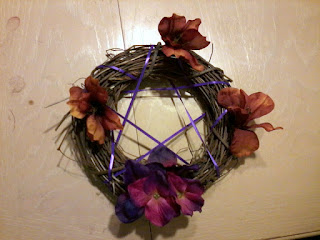 |
| The Lughnasa wreath experiment |
So it's getting close to Lughnasa again and this year I am trying something a little bit different. Usually my Lughnasa involves a family picnic and either some hiking and plant collecting or some age appropriate physical games. This year though we are facing health problems on several fronts that make an active outdoor Lughnasa much more complicated so I decided we needed a back-up plan. I noticed several people talking about Lughnasa as a time for both the traditional activity of bread baking and also of crafting, and I thought maybe this would be a good direction to go in.
I am researching how to make my own bread from scratch and plan to make some for Lughnasa. My friends have had several great suggestions about how to approach this new project and I truly appreciate all the advice I've gotten, from recipes to how to properly get the dough to rise. Also - great advice indeed - to have several trial runs before cooking for the actual holy day. I'll be sure to post after Lughnasa to let you all see how it goes.
Another inspiration I had was to try embroidery, after a good friend suggested it was an easy sowing craft to get into. I went to the store today to look for supplies and I admit I lost my nerve; the array of options was a bit too overwhelming for me without having a certain idea of what I was doing. But when I saw a set of grape wreathes I had a bit of an inspiration for a craft I have done before which can be time consuming but is easy and fun - making my own decorated wreath. I decided to pick up some basic supplies and give it a go today to see how it was and get a better plan for what to do with it on Lughnasa next week. The children wanted to make one too so we purchased a large wreath and a small one, ribbon, and assorted fake flowers. The easiest shape I know how to make on such a wreath is a basic star, so that is what we did, although I am now trying to figure out how to do a more complicated shape, perhaps a triquetra. The project was fun and not too difficult and the girls enjoyed it, so I will definitely start planning a more intricate version for the holiday.
 |
| The children's wreath |
Since I had the ribbon I also decided to decorate a blank book, as the one I have for keeping notes on my Druidic material is nearly full and needs a second volume. This is something I have done many times before and something I enjoy doing; I had never really thought of it as crafty, per se, but as I was working on it I found myself reflecting on the different ways that Lughnasa crafts can be expressed. Perhaps there is something appropriate in making decorative wreath to bless my home and a book to write about my spirituality in on a holiday associated with harvesting; certainly I found myself reflecting on the year and what I have harvested in my own life. I think next week on the actual holiday I will intentionally work this retrospective aspect into the craftwork, perhaps as a discussion with my children where we can all share our thoughts on the past few months.
 |
| The cover of the new book - the image is from a greeting card |
 |
| The inside cover of the new book - image is also a greeting card |


.bmp)